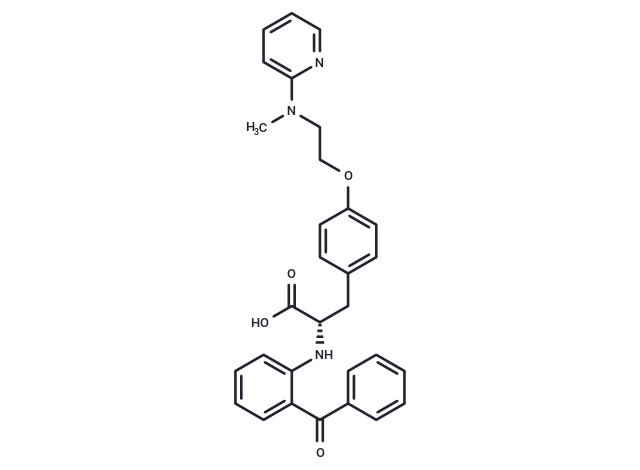Shopping Cart
- Remove All
 Your shopping cart is currently empty
Your shopping cart is currently empty

GW1929 is a potent PPAR-γ agonist (pKi: 8.84 for human PPAR-γ; pEC50s of 8.56 and 8.27 for human and murine PPAR-γ).

| Pack Size | Price | Availability | Quantity |
|---|---|---|---|
| 1 mg | $30 | In Stock | |
| 5 mg | $68 | In Stock | |
| 10 mg | $113 | In Stock | |
| 25 mg | $235 | In Stock | |
| 50 mg | $425 | In Stock | |
| 100 mg | $616 | In Stock | |
| 1 mL x 10 mM (in DMSO) | $76 | In Stock |
| Description | GW1929 is a potent PPAR-γ agonist (pKi: 8.84 for human PPAR-γ; pEC50s of 8.56 and 8.27 for human and murine PPAR-γ). |
| Targets&IC50 | PPARγ (human):8.84 (pKi) |
| In vitro | GW1929 is a potent PPAR-γ activator, with pEC50s of 8.56 and 8.27 for human PPAR-γ and murine PPAR-γ, and pKis of 8.84, < 5.5, and < 6.5 for human PPAR-γ, PPAR-α, and PPAR-δ, respectively [1]. GW1929 (10 μM) inhibits TBBPA-induced caspase-3 increase and TBBPA-stimulated LDH release in neocortical cell cultures [2]. |
| In vivo | GW1929 (0.5, 1, 5 mg/kg, p.o.) highly decreases nonfasted plasma glucose levels in Zucker diabetic fatty (ZDF) rats after treatment for 14 days and possesses antilipolytic efficacy. In ZDF rats, GW1929 (1, 5 mg/kg, p.o.) increases glucose-stimulated insulin secretion of β-cell [1]. |
| Kinase Assay | Ligand binding to bacterially expressed ligand-binding domain (LBD) of hPPAR-γ is determined by the scintillation proximity assay (SPA). The assay measures the ability of putative ligands to displace receptor-bound [3H]BRL 49653. Assays are conducted in 96-well plates. Wells contained varying concentrations of GW1929 or troglitazone; streptavidin-modified SPA beads to which biotinylated PPAR-γ LBD is prebound; and 10 nM of the specific radioligand [3H]BRL 49653 in a volume of 100 μL. The amount of nonspecific binding, as assessed by control wells that contained 50 μM of the corresponding unlabeled ligand, is subtracted from each data point. For each compound tested, plots of ligand concentration versus counts/min of radioligand bound are constructed, and apparent Ki values are estimated from a nonlinear least-squares fit of the data, assuming simple competitive binding. The results are expressed as pKi, where pKi = -log10(KI) [1]. |
| Cell Research | For the experiments, the cells are plated in 96-well plates at a density of 2 × 10^5 cells per cm2 and cultured in the presence of TBBPA, in concentrations ranging from 1 nM to 100 μM TBBPA. TBBPA is dissolved in DMSO, resulting in a final vehicle concentration of 0.1 % (v/v). Control (no vehicle) and DMSO-treated wells are included in the experimental design to determine the effect of DMSO. To study whether PPAR-γ is involved in the neurotoxic effect of TBBPA, cells are co-treated with 10 μM TBBPA and 10 μM GW1929 or GW9662. After 6 or 24 h of culture, 100 μL medium is collected for the LDH analysis, and the cells are collected and frozen at ?70°C for the caspase-3 activity measurements [2]. |
| Animal Research | Animals are housed at 72°F and 50% relative humidity with a 12-h light and dark cycle and fed Formulab Diet 5008. Age- (60-day) and glucose-matched male Zucker diabetic fatty rats are gavaged twice daily for 14 days with vehicle (0.05 M N-methylglucamine), GW1929 (0.5, 1.0, or 5.0 mg/kg), or troglitazone (as the milled extrudate, in a suspension in methylcellulose, 50, 150, and 500 mg/kg). Another group of animals receives a mixture of Humulin N and Humulin R by subcutaneous injection twice daily. On days 7 and 14 of dosing, nonfasted measurements of glucose, lactate, insulin, total cholesterol, TGs, F FAs, and hematocrit are obtained. On day 14 of dosing, samples for serum drug levels (2-h postdose) and glycosylated hemoglobin measurements are also collected. In addition, once weekly, three animals from each group are placed in metabolic chambers for 48 h for quantitation of 24-h food and water consumption. Body weights are recorded throughout the study. At the conclusion of the study, perfused pancreas experiments are performed on 12 animals (n = 4 per group) that have received either GW1929 (1 and 5 mg/kg) or vehicle, to directly evaluate the effects of treatment on basal and glucose-stimulated insulin secretion. The remaining animals are killed, and their pancreases are processed for immunocytochemistry [1]. |
| Molecular Weight | 495.57 |
| Formula | C30H29N3O4 |
| Cas No. | 196808-24-9 |
| Smiles | CN(CCOc1ccc(C[C@H](Nc2ccccc2C(=O)c2ccccc2)C(O)=O)cc1)c1ccccn1 |
| Relative Density. | 1.264 g/cm3 (Predicted) |
| Storage | Powder: -20°C for 3 years | In solvent: -80°C for 1 year | Shipping with blue ice. | ||||||||||||||||||||||||||||||
| Solubility Information | DMSO: 33 mg/mL (66.59 mM), Sonication is recommended. | ||||||||||||||||||||||||||||||
Solution Preparation Table | |||||||||||||||||||||||||||||||
DMSO
| |||||||||||||||||||||||||||||||

Copyright © 2015-2025 TargetMol Chemicals Inc. All Rights Reserved.